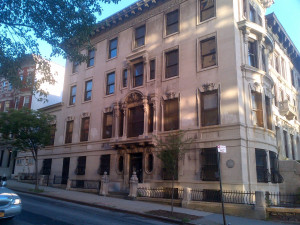
280 Convent Street, Manhattan. Image Credit: Committee for Preservation of the Hamilton Heights/Sugar Hill Historic District.
A recent decision by the Landmarks Preservation Commission to approve a non-compliant addition to a building within an historic district has enraged residents who are held to stricter standards, and preservationists who see the floodgates opening to the deterioration of the historic districts on a broader scale.
On November 26, 2013, two days before Thanksgiving, City College of New York (CCNY) quietly received Landmarks approval of a renovation plan for a townhouse at 280 Convent Avenue, Manhattan, within the historic district of Hamilton Heights. The renovation will include the construction of a 50-foot tall modernist addition visible from several streets, and a north side wall built of nearly solid concrete. The Beaux-Arts townhouse, vacant for over 20 years, was once slated to be the Charles Rangel Center for Government Studies, and is now, with significant funding from Gen. Colin Powell, to be the Colin Powell School for Global and Civic leadership. While community leaders and preservationists have been clamoring for CCNY to improve the maintenance of the vacant structure, and to renovate and put the building to good use, now they say “Renovation yea, Addition no way.”
CCNY’s architects, ENNEAD, is a firm which has made its mark designing large modernist additions to large institutions on large tracts of land, such as the Rose Center (planetarium) at the American Museum of Natural History. The rowhouse at 280 Convent Avenue is not a large institution on a large tract of land.
The proposed addition violates at least five of Landmark’s nine requirements for Section 2-16, Rear Yard Additions or Enlargements to Row Houses in Historic Districts: (b), the proposed addition or enlargement will not extend to the rear lot line or substantially eliminate the presence of a rear yard; (c), a majority of the other buildings in the block feature comparable or larger rear yard additions or enlargements in terms of their projection into the rear yard; (d), the proposed addition or enlargement does not rise to the full height of the building and is not taller than the predominant height of existing additions or enlargements in the block; (f), the rear of the building retains the scale and character of an individual rowhouse; and (g), the proposed addition or enlargement is not visible from a public thoroughfare or right of way.
The addition is for a stairwell which appears to be able to be integrated into the new plans, within the existing structure, as most of the building will be open-plan research space (lounges, galleries, etc.). The approval appears to have been granted without the consent of the community or the State Historic Preservation Office, with which CCNY as a state-funded facility is normally obligated to consult. Individual homeowners in the district, meanwhile, have been issued Landmarks violations for installing security cameras on their homes to catch the graffiti vandals who deface their historic properties, and challenged on installing new energy-efficient windows, or updating the rear of their home which is not visible from the street.
The Historic Districts Council and local preservationists sent letters to Landmarks during the review period requesting that alternatives to the CCNY plan which could eliminate the addition be studied. The letters appear to have been ignored. Landmarks did not ask for alternatives to be evaluated, did not make any comments, and gave away the store. A dual-standard policy is, at the least, improper for a public agency.
Of greater concern citywide is the precedent that this approval sets – that any big institution (or developer) can easily puncture the fabric of historic districts. Once a precedent is set, others will follow. Our historic districts will disappear in a patchwork of bigger and more contrasting additions. This situation is occurring citywide as Landmarks grants approvals for modernist additions and inserts within historic districts.
After months of letters, emails, and voicemail messages requesting meetings with the respective representatives of CCNY and CUNY, there has been no response from any of these parties. It appears that CCNY intends to steamroll their concrete monolith over all objections.
The Commission must hold all projects to the same rules, regulations, and guidelines. CCNY must redesign its Powell Center to eliminate the addition and retain the historic character of the community it also lives within, and serves.
Noël Weekes, Jr., Executive Director, Health Science Education, Inc. and Media Coordinator, Committee for the Preservation of the Hamilton Heights/Sugar Hill Historic District
UPDATE:
The Landmarks Preservation Commission issued the following response:
“The article incorrectly states that the proposed addition at 280 Convent Avenue violates five of the Landmarks Commission’s nine requirements for rear yard additions or enlargements to row houses in historic districts. The standards cited by the author (Section 2-16, Title 63 of the Rules of the City of New York) only apply to additions approvable by the Commission’s staff without going to a public hearing. In the case of 280 Convent Avenue, the applicant went through the public hearing process, which includes presenting the proposal to the Landmarks Commissioners, with an opportunity for public testimony on the project, and thus the standards for staff-level approvals mentioned do not apply.”


There has been no “public hearing”…there has been nothing but secrecy and an unpublicized meeting at which those of us who live in this “Landmarked” area were spoken down to as though we were a group of two-year-olds and all of the plans were something which we did not “understand”. The so-called “opportunity for public testimony” is scheduled and no one who may oppose the plan is notified of a meeting. City College is desperately in need of making changes to existing buildings for handicapped students…why are they so eager to build an elevator shaft as an addition to this residential property? This is a mystery!